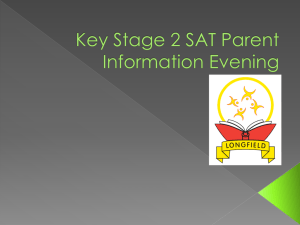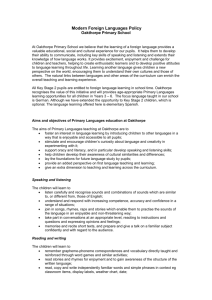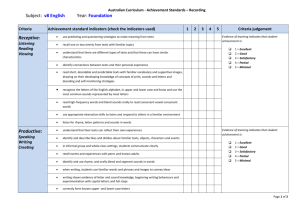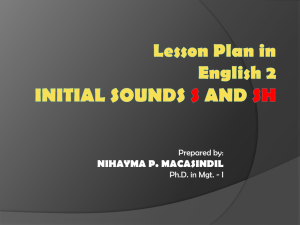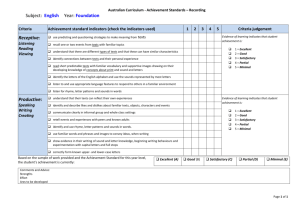Reading Levels National Curriculum 1-3
advertisement
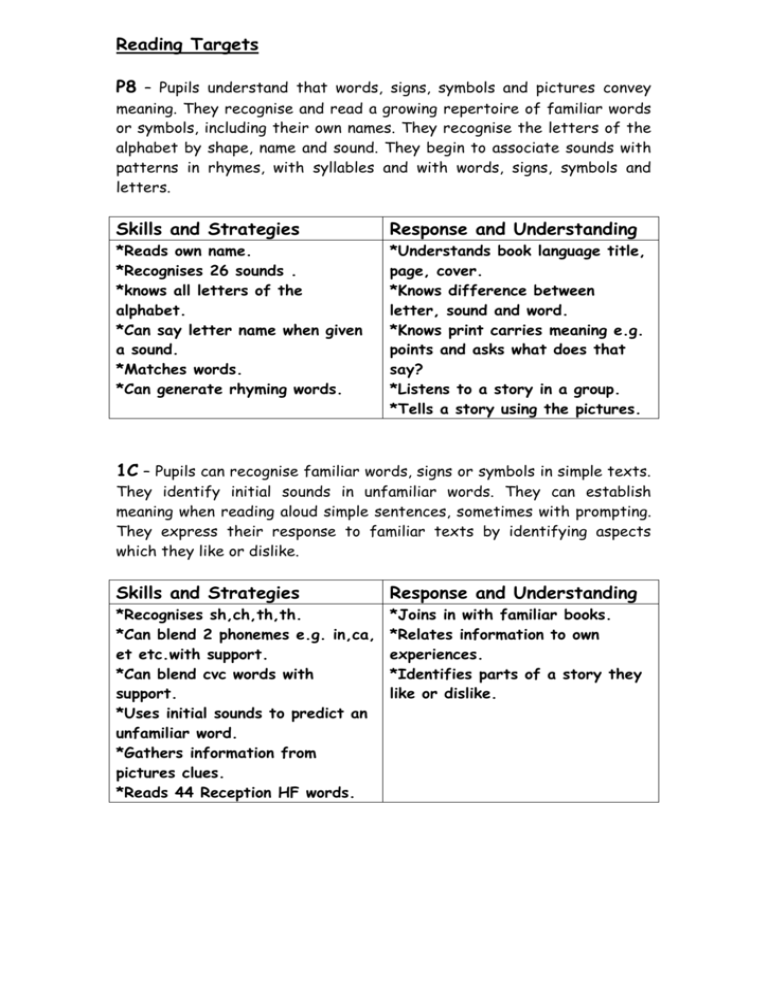
Reading Targets P8 – Pupils understand that words, signs, symbols and pictures convey meaning. They recognise and read a growing repertoire of familiar words or symbols, including their own names. They recognise the letters of the alphabet by shape, name and sound. They begin to associate sounds with patterns in rhymes, with syllables and with words, signs, symbols and letters. Skills and Strategies Response and Understanding *Reads own name. *Recognises 26 sounds . *knows all letters of the alphabet. *Can say letter name when given a sound. *Matches words. *Can generate rhyming words. *Understands book language title, page, cover. *Knows difference between letter, sound and word. *Knows print carries meaning e.g. points and asks what does that say? *Listens to a story in a group. *Tells a story using the pictures. 1C – Pupils can recognise familiar words, signs or symbols in simple texts. They identify initial sounds in unfamiliar words. They can establish meaning when reading aloud simple sentences, sometimes with prompting. They express their response to familiar texts by identifying aspects which they like or dislike. Skills and Strategies Response and Understanding *Recognises sh,ch,th,th. *Can blend 2 phonemes e.g. in,ca, et etc.with support. *Can blend cvc words with support. *Uses initial sounds to predict an unfamiliar word. *Gathers information from pictures clues. *Reads 44 Reception HF words. *Joins in with familiar books. *Relates information to own experiences. *Identifies parts of a story they like or dislike. 1B – Pupils can read a range of familiar words and symbols and identify initial and final sounds in unfamiliar words. With support, they use their knowledge of letters, sounds and words to establish meaning when reading aloud. They respond to events and ideas in all genres. Skills and Strategies Response and Understanding *Uses initial and final sounds to predict unknown words. *Blends cvc words. *Attempts ccvc and cvcc words. *Reads words with er, or and ar. *Uses final sounds ng,ck,ss,ll,ff. *Asks about signs and symbols. *Stops at a full stop. *Understands terms author, illustrator, publisher and blurb. *Can answer questions about texts (where,why,who,when,what) *Explains differences between fact and fiction. 1A – Pupils use their knowledge of letters, sounds and words to read simple texts with meaning. They comment on events or ideas in all genres. Skills and Strategies Response and Understanding *Blends monosyllabic words confidently. *Self corrects if sentence doesn’t make sense. *Predicts unknown words from context. *Reads on to end of sentence to predict unknown word with support. *Uses dictionary with support using alphabetical order. *Begins to recognise some long vowel phonemese.g. ee,ay,ie,oa. *Reads all Year 1 HF words. *Uses terms author, illustrator, publisher and blurb. *Retrieves information with reference to the text. *Relates texts to other books and situations e.g. Can you think of anything/anyone else who…? 2C – Pupils read most of a simple text independently and use phonic, grammatical and contextual clues. They may need support to establish meaning. They show understanding of texts, recount the main facts or events with support and comment on obvious features of the text. Skills and Strategies Response and Understanding *Reads on to end of sentence to predict unknown words independently. *Uses long vowel phonemes ee,ai,ay. Begins to develop pace by looking at 2,3 words at a time. *Begins to use context page and locates information by page number. *Uses dictionary independently. *Attempts polysyllabic words. *Explain and comment on writer’s use of language e.g. which words tell you that…? *Retells a story with a beg, mid and end all linked. *Follows simple written instructions. Uses imagination to begin to comment on what is read. 2B – Pupils’ reading of simple unfamiliar texts is almost entirely accurate and well-paced, taking some account of punctuation. When reading unfamiliar words or symbols they combine a range of strategies phonic, grammatical and contextual to establish meaning. They show understanding of texts by commenting on features such as plot, characters and how information is presented. Skills and Strategies Response and Understanding *Reads with pace by linking 4,5,6 words at a time. *Uses all long vowel phonemes. *Reads all Year 2 HF words. *Uses headings, captions, symbols to gather information. *Begins to change voice to show awareness of “ ” ? and ! *Maintains meaning by making connections between sentences and from one part of text to another. *Makes deductions about characters feelings and actions from what they say and do. 2A – Pupils read simple unfamiliar texts accurately. Their independent reading shows they can read ahead and make use of expression and intonation to enhance meaning. In responding to stories, they identify and comment on characters and how they relate to one another. They express opinions about events and actions and comment on some of the ways in which a text is written or presented. Skills and Strategies Response and Understanding *Use index and glossary with support. *Scans ahead to read with appropriate expression. *Uses commas to help pace reading. *Searches texts and draws on presentation to retrieve specific details. *Recognises similar meanings when expressed in different words or phrases. *Finds reasons in a text to explain why. *Draws out general ideas and overall sense of a text. 3 – Pupils read a range of texts fluently and accurately. They read independently, using strategies appropriately to establish meaning. In responding to fiction and non fiction they show understanding of the main points and express preferences. They use their knowledge of the alphabet to locate books and find information. Skills and Strategies Response and Understanding *Uses index and glossary to enhance meaning of nf texts. *Speculates what a book may be about by skim reading. *Scans to locate information quickly. *Uses context to work out meanings of unfamiliar words. *Identifies themes and comments on writers’ purposes and viewpoints e.g. what can you learn about…from…?

